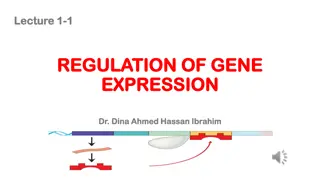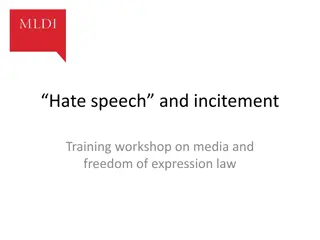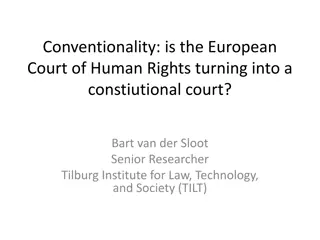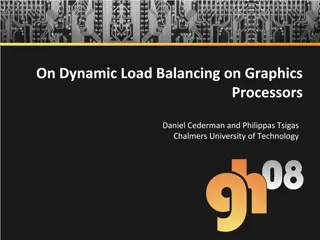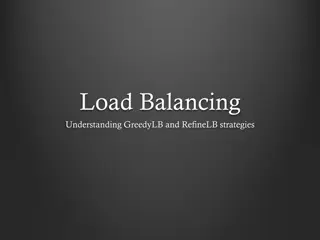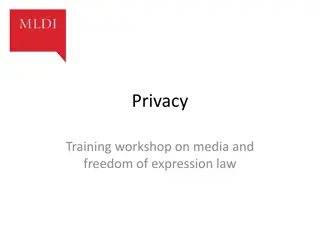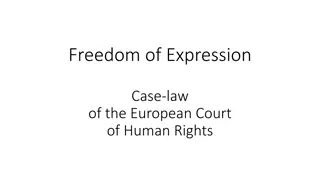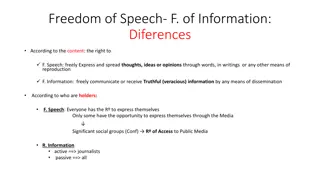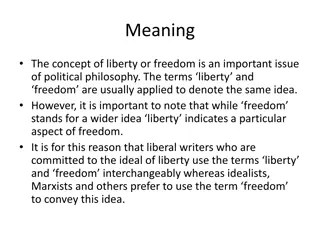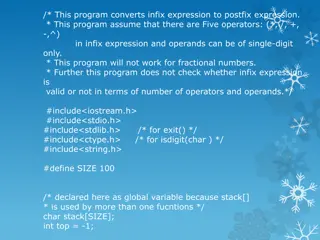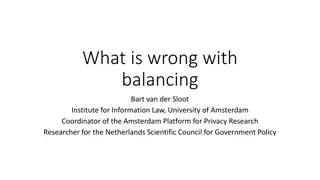Balancing Freedom of Expression and Right to Private Life in Recent ECtHR Practice
The European Court of Human Rights (ECtHR) grapples with balancing the fundamental rights of freedom of expression and the right to private life. While the criteria applied are deemed relevant and reasonable, inconsistency in their application has been observed. This study critiques the ECtHR's decision-making process, noting instances where it has assumed a final arbiter role. The intersection of Article 10 (freedom of expression) and Article 8 (right to private life) is explored, emphasizing the pivotal role these rights play in a democratic society.
Download Presentation

Please find below an Image/Link to download the presentation.
The content on the website is provided AS IS for your information and personal use only. It may not be sold, licensed, or shared on other websites without obtaining consent from the author. Download presentation by click this link. If you encounter any issues during the download, it is possible that the publisher has removed the file from their server.
E N D
Presentation Transcript
Balancing the Freedom of Expression and Right to Private Life in the Recent Practise of the ECtHR P ivi Korpisaari, Professor in Communication Law University of Helsinki, Faculty of Law (c) P ivi Korpisaari, 4.12. University of M nster www.helsinki.fi/yliopisto 1
Content Freedom of expression and right to private life Some facts about the ECtHR Balancing criteria Contribution to a debate of general interest How well known he person concerned is and what is the subject of the report Prior conduct of the person concerned The Content, form and consequences of the publication How the information is obtained Proportionality of the sanctions imposed Critical opinions and discussion Conclusions (c) P ivi Korpisaari, 4.12. University of M nster www.helsinki.fi/yliopisto 2
Findings The criteria that ECtHR has applied when balancing the right to private life and freedom of expression are relevant and reasonable but Their application has at times been inconsistent and variable At times the ECtHR has acted like the last instance deciding what is the best solution (c) P ivi Korpisaari, 4.12. University of M nster www.helsinki.fi/yliopisto 3
Freedom of expression, Art 10 Freedom to hold opinions and to receive and impart information and ideas without interference by a public authority and regardless of frontiers freedom of expression constitutes one of the essential foundations of a democratic society and one of the basic conditions for its progress and each individual's self- fulfilment Also applies to those expressions that offend, shock or disturb Press s task to impart information and ideas and act like a public watchdog Subject to exceptions, Art. 10(2) (c) P ivi Korpisaari, 4.12. University of M nster www.helsinki.fi/yliopisto 4
Right to Private life, art 8 Physical, psychological and moral integrity of a person Also the right to establish and develop relationships with other human beings and activities of a professional or business nature The right to personal information, which individuals can legitimately expect should not be published without their prior consent Protection of reputation and honour, if the attack on personal honour and reputation attains a certain level of gravity Right to family life, home and secrecy of correspondence (c) P ivi Korpisaari, 4.12. University of M nster www.helsinki.fi/yliopisto 5
Right to private life Until the early 2000 s that aspect of private life that covers the right to personal information which shouldn t be published or otherwise widely disseminated without consent of the person in question, was considered an acceptable limitation of the freedom of expression In the current court practice the right to private life is considered as an equivalent right to freedom of speech This has complicated the task of weighing up and balancing the competing claims of the protection of private life and freedom of expression The line of interpretation has raised concerns (c) P ivi Korpisaari, 4.12. University of M nster www.helsinki.fi/yliopisto 6
http://t0.gstatic.com/images?q=tbn:ANd9GcS70v4ivMTum30qaK839Q2Y42KusHZxOGhrUGc9rJMX3sZ7q9t82WH3yTghttp://t0.gstatic.com/images?q=tbn:ANd9GcS70v4ivMTum30qaK839Q2Y42KusHZxOGhrUGc9rJMX3sZ7q9t82WH3yTg http://t1.gstatic.com/images?q=tbn:ANd9GcSv6IKwP0ju68iJ1Kb3hG5X2zKR00fsLOIDFbWeqWI-srZeC7cWJaJybR8 http://t2.gstatic.com/images?q=tbn:ANd9GcTAF5kbPZo0Yr8XvFv1x9uvCe8sJHOqkLdL4juME1hSmeUQHspvJl6iWMo (c) P ivi Korpisaari, 4.12. University of M nster 7
Statistics 1.1.-31.10.2017, ECtHR Applications allocated to a judicial formation 58 300 (2016: 41 200 / + 42 %) Applications decided 72 444 (2016: 31 678 / + 129 %) Pending applications 64 650 (79 750 / -19 %) In 2016, almost half the judgments concerned 4 of the 47 member States (The Russian Federation 228, Turkey 88, Romania 86 and Ukraine 73) Since 1959, more than a quarter of the judgments delivered by it have concerned 2 member States (Turkey 3,270 and Italy 2,351). At least one violation found in 83 % of the judgments in 2016 Source for statistics and figures above: www.echr.coe.int (c) P ivi Korpisaari, 4.12. University of M nster www.helsinki.fi/yliopisto 10
Margin of appreciation [t]he Court s task, in exercising its supervisory jurisdiction, is not to take the place of the competent national authorities but rather to review under Article 10 the decisions they delivered pursuant to their power of appreciation. (Delfi 131) National authorities have to apply standards which are conformity with the principles of Art 10 Delfi AS 131 (c) P ivi Korpisaari, 4.12. University of M nster www.helsinki.fi/yliopisto 11
Margin of appreciation [w]here the balancing exercise between those two rights has been undertaken by the national authorities in conformity with the criteria laid down in the Court s case-law, the Court would require strong reasons to substitute its view for that of the domestic courts (Delfi 139, Couderc 92) there will usually be a wide margin afforded by the Court if the State is required to strike a balance between competing private interests or competing Convention rights. (Delfi 139) The outcome shouldn t vary according to whether it has been lodged with the Court under 8 or 10 Article (c) P ivi Korpisaari, 4.12. University of M nster www.helsinki.fi/yliopisto 12
Balancing criteria Contribution to a debate of general interest How well known the person concerned is and what is the subject of the report Prior conduct of the person concerned The Content, form and consequences of the publication How the information is obtained Proportionality of the sanctions imposed (c) P ivi Korpisaari, 4.12. University of M nster www.helsinki.fi/yliopisto 13
1) Contribution to a debate of general interest Political issues, crimes, sporting issues or performing artists, seal hunting, how the police investigated a crime, how the state managed the assets, patient safety Publishing photos revealing a person s private life without their consent, has to contribute to a debate which is of general interest In von Hannover (N.o 2) the threshold for considering the photograph as a matter of general interest was set very low In my opinion publishing a legally taken harmless picture of a public figure walking in a public place with her husband cannot cause that kind of harm that would or should be legally prohibited by the ECHR In von Hannover No 2 the Court ignores the argument that the attack has to attain a certain level of gravity and be in a manner causing prejudice to personal enjoyment of the right to respect for private life (c) P ivi Korpisaari, 4.12. University of M nster www.helsinki.fi/yliopisto 14
1) Contribution to a debate of general interest GC Couderc and Hachette Filipacchi Associ s v. France (10.11.2015): Assess the publication as a whole + context the only decisive question is whether a news report is capable of contributing to a debate of public interest, and not whether it achieves this objective in full ( ) for an article to contribute to a debate of public interest, it is not necessary that it be devoted entirely to that; it may be enough for the article to be concerned with that debate and to contain one or several elements for that purpose ( 110) (c) P ivi Korpisaari, 4.12. University of M nster www.helsinki.fi/yliopisto 15
1) Contribution to a debate of general interest although the impugned article admittedly contained numerous details which concerned solely private or even intimate details of the Prince s life, it was also intended to contribute to a debate on a matter of public interest ( 113) Does this give an excuse to tabloid journalism where intimate and private things are revealed under the guise of matter of general interest?? (c) P ivi Korpisaari, 4.12. University of M nster www.helsinki.fi/yliopisto 16
2) How well known the person concerned is and what is the subject of the report The role or function of the person concerned and the nature of the activities that are the subject of the news report a distinction has to be made between private individuals and persons acting in a public context, as political figures or public figures. Accordingly, whilst a private individual unknown to the public may claim particular protection of his or her right to private life, the same is not true of public figures [ ] (GC, Axel Springer AG v. Germany, 7.2.2012 91) (c) P ivi Korpisaari, 4.12. University of M nster www.helsinki.fi/yliopisto 17
2) How well known he person concerned is and what is the subject of the report Private individuals / celebrities / civil servants of different kind /politicians Individual s celebrity or functions cannot under any circumstances justify hounding by the media or the publication of photographs obtained through fraudulent or clandestine operations (Couderc 122) (c) P ivi Korpisaari, 4.12. University of M nster www.helsinki.fi/yliopisto 18
3) Prior conduct of the person concerned Revelations, once made public by the person concerned, weaken the degree of protection The mere fact of having cooperated with the press on previous occasions cannot serve as an argument for depriving a person discussed in an article of all protection Article 8 doesn t give protection against loss of reputation, which is the foreseeable consequence of one s own actions such as, for example, the commission of a criminal offence (c) P ivi Korpisaari, 4.12. University of M nster www.helsinki.fi/yliopisto 19
4 a) Circumstances in which the photos were taken, and how the information is obtained Consent Whether the photographing was done without knowledge of the person in the photograph or by subterfuge or other illicit means; and The nature or seriousness of the intrusion and the consequences of publication of the photo for the person concerned (c) P ivi Korpisaari, 4.12. University of M nster www.helsinki.fi/yliopisto 20
4b) Method of obtaining the information and its veracity Journalists right to divulge information on issues of general interest is subject to the proviso that they are acting in good faith and on an accurate factual basis and that they provide reliable and precise information in accordance with the ethics of journalism Of signifigance that the photos were handed over voluntarily and without charge to the press (Couderc 135) Photographs were not taken without subjects knowledge or in circumstances showing him in an unfavourable light (Couderc 135) (c) P ivi Korpisaari, 4.12. University of M nster www.helsinki.fi/yliopisto 21
5) The content, form and consequences of the publication a person s image constitutes one of the chief attributes of his or her personality, as it reveals the person s unique characteristics and distinguishes the person from his or her peers. The right to the protection of one s image is thus one of the essential components of personal development . In the Court s opinion this mainly presupposes that the individual has a right to control the use of that image, including the right to refuse publication thereof (von Hannover N:o 2 92; see also Reklos and Davourlis v. Greece, 40) (c) P ivi Korpisaari, 4.12. University of M nster www.helsinki.fi/yliopisto 22
5) The content, form and consequences of the publication The way in which the photograph or report are published The manner in which the person concerned is represented The extent to which the information has been disseminated (c) P ivi Korpisaari, 4.12. University of M nster www.helsinki.fi/yliopisto 23
6) The content, form and consequences of the publication What details ought to be published to ensure an article s credibility (Couderc 139 and 146) Tone of the interview (Couderc 141) Whether the secrecy of the matter has been undermined previously (Couderc 150) (c) P ivi Korpisaari, 4.12. University of M nster www.helsinki.fi/yliopisto 24
7) Proportionality of the sanctions imposed / Severity of the sanction Compensation liability, punishment, confiscation or compensating legal costs The outcomes of the Court have also been very difficult to predict in this respect Reasoning followed in the national judgment The nature of the information that is revealed Level of compensation in general in the country in question matters Abusing of freedom of expression => high level of compensation OK (c) P ivi Korpisaari, 4.12. University of M nster www.helsinki.fi/yliopisto 25
Discussion Dirk Voorhoof: It has become common knowledge amongst Strasbourg observers that the Grand Chamber of the European Court of Human Rights doesn t have the best reputation in terms of guaranteeing the right of freedom of expression and information. http://echrblog.blogspot.fi/2016/04/guest-post-grand-chamber- judgment-bedat.html Two judges strongly dissent in GC judgment B dat v. Switzerland (29.3.2016): This Court had always regarded the press as the servant of an effective judicial system, granting little scope for restrictions on freedom of expression in such matters as the public interest in the proper administration of justice. In my view, the present judgment constitutes a regrettable departure from this long-established position. (c) P ivi Korpisaari, 4.12. University of M nster www.helsinki.fi/yliopisto 26
Discussion Dissenting judges Wojtyczek and K ris in F rst-Pfeifer v. Austria (17.5.2016): This judgment has several major flaws. Firstly, the assurance that the rights guaranteed by [the] provisions [of Articles 8 and 10 of the Convention] deserve equal respect (see paragraph 38 of the judgment), seems to be but a dead letter. The judgment is structured and reasoned in such a way that Article 10 is given pre-eminence over Article 8. Secondly, the Court s case-law is applied selectively and offhandedly. Important elements thereof, pertaining to the heart of respect for privacy, are suppressed, whereas those related to the freedom of the media are emphasised. Thirdly, the reasoning is based on misrepresentation and misinterpretation of the facts. Some pertinent facts are passed over in silence, and certain important factual questions are not raised at all. Had they been raised explicitly and objectively, the overall finding could scarcely have been the same. (c) P ivi Korpisaari, 4.12. University of M nster www.helsinki.fi/yliopisto 27
Discussion Combined together, these flaws have produced the most regrettable result a one-sided, unbalanced and, it appears, fundamentally unjust judgment. Nonetheless, the fact that issues under Articles 8 and 10 are intertwined is not an excuse for transforming an Article 8 case into an Article 10 case in such a way that the rights under Article 8 have only secondary significance. Yet this is precisely what we have at hand. von Hannover criteria has not been applied Having thus paved the way for an examination under Article 10, the majority seems to ignore Article 8 as its own starting point. (c) P ivi Korpisaari, 4.12. University of M nster www.helsinki.fi/yliopisto 28
Discussion Dissenting opinion of judge Motoc: the basic principles of Article 8 and ultimately human dignity tend to be forgotten in the process (c) P ivi Korpisaari, 4.12. University of M nster www.helsinki.fi/yliopisto 29
Conclusion The case law concerning freedom of expression and the right to private life has become more and more difficult to predict Information in photographic form has enjoyed a large degree of protection but in general it has to relate to a matter of general interest Also intimate and private details can be revealed, if the matter as a whole relates to a matter of public interest Maybe it would be better to estimate whether the infringement to privacy is so serious that the right of privacy deserves protection (c) P ivi Korpisaari, 4.12. University of M nster www.helsinki.fi/yliopisto 30
Conclusions The old general principles of interpretation still prevail, but applying them to individual cases has in some cases appeared inconsistent High level of protection of freedom of speech and the important role of the press as a public watchdog, are still valid, but their importance has, in some cases, diminished and the Court has been critisised for that The way how the doctrine of margin of appreciation has been applied is incoherent (c) P ivi Korpisaari, 4.12. University of M nster www.helsinki.fi/yliopisto 31
Thank you for your attention! Photo by P ivi Korpisaari (c) P ivi Korpisaari, 4.12. University of M nster www.helsinki.fi/yliopisto 32



